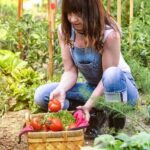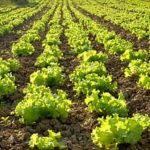Container gardening offers a versatile and convenient way for individuals with limited outdoor space to grow their own fresh produce. Whether you live in an apartment, have a small patio, or simply want to add some greenery to your home, this gardening method allows you to cultivate an array of vegetables right on your doorstep. In this article, we will delve into the world of container gardening and discover the best vegetables suited for this method.
The concept of container gardening revolves around the idea of growing plants in various types of containers, such as pots, grow bags, and hanging baskets, rather than traditional garden beds. This approach is particularly beneficial for urban dwellers or individuals with restricted outdoor areas, as it provides a practical solution for cultivating vegetables in limited spaces. By choosing the right vegetables and employing proper care techniques, anyone can enjoy a bountiful harvest from their container garden.
In the following sections, we will explore the essentials of container gardening, from selecting suitable containers to nurturing thriving vegetable plants. We will also highlight the specific challenges and solutions associated with this unique form of gardening.
Additionally, we will provide insights into success stories and valuable tips for achieving successful container vegetable gardens. Whether you are new to gardening or looking to elevate your horticultural skills, this guide will equip you with the knowledge and inspiration needed to embark on your own container gardening journey.
Best Container Options
When it comes to container gardening, the options for suitable containers are diverse and versatile. For urban dwellers or individuals with limited outdoor space, finding the right container is essential for successful vegetable gardening. Here are some of the best container options for growing vegetables on patios, balconies, or even windowsills:
Pots
Pots are a classic choice for container gardening. They come in various sizes, shapes, and materials, allowing for flexibility in creating a personalized vegetable garden. Whether you prefer terracotta, ceramic, or plastic pots, make sure to select ones with proper drainage holes to prevent waterlogging.
Grow Bags
Grow bags have gained popularity in recent years due to their practicality and affordability. Made from breathable fabric, they provide excellent aeration and drainage for vegetable roots. Additionally, grow bags are lightweight and easy to move around, making them an ideal option for small spaces.
Hanging Baskets
Hanging baskets offer a unique way to showcase vegetables while maximizing vertical space. Cherry tomatoes, peppers, and strawberries are especially well-suited for hanging baskets due to their cascading growth habits. With proper support and secure hanging mechanisms, these containers can add visual interest to any garden space.
Choosing the right container is crucial when it comes to cultivating vegetables suited for container gardening successfully. Each option provides distinct advantages depending on individual preferences and available space constraints.
Choosing the Right Soil
When it comes to container gardening, one of the most crucial factors for success is choosing the right soil. The soil in a container needs to provide essential nutrients, proper drainage, and a suitable environment for vegetable plants to grow and thrive. Whether you are using pots, grow bags, or hanging baskets, selecting the appropriate soil mix is vital for the overall health and productivity of your container garden.
Understanding Soil Mixes for Containers
In container gardening, regular garden soil is not ideal due to its tendency to compact and lack of adequate drainage. Instead, opt for a high-quality potting mix specifically formulated for containers. These mixes typically contain a combination of materials such as peat moss, perlite, vermiculite, and compost to provide a well-balanced growing medium. It’s important to choose a mix that is lightweight, well-aerated, and moisture-retentive to support healthy root development.
Creating a Nutrient-Rich Environment
To ensure that your vegetables have access to essential nutrients, consider adding organic matter or slow-release fertilizers to the soil mix before planting. Organic matter such as compost or worm castings can improve the overall fertility of the soil and promote beneficial microbial activity. Additionally, incorporating slow-release fertilizers will supply a steady source of nutrients over an extended period, supporting continuous growth and fruit production throughout the growing season.
Tips for Maintaining Soil Quality
Regularly monitoring the moisture levels of the soil is crucial in container gardening. Adequate watering is necessary to keep the soil consistently moist but not waterlogged. Over time, repeated watering can leach out essential nutrients from the soil mix. To address this issue, consider periodically applying liquid organic fertilizers or adding additional layers of compost on top of the soil surface throughout the growing season to replenish lost nutrients.
By understanding the importance of selecting an appropriate soil mix and maintaining its quality in container gardening, you can create an optimal environment for growing vegetables suited for this method. With careful attention to soil health and nutrient management, you can ensure that your container vegetables have everything they need to flourish and yield a bountiful harvest.
Selecting Vegetables for Container Gardening
When it comes to selecting vegetables for container gardening, it is important to consider the specific needs of each plant, as well as the limitations of the container itself. Certain vegetables are better suited for this method of gardening due to their compact growth habits, moderate space requirements, and sunlight needs. By choosing the right vegetables for your containers, you can maximize your harvest and create a thriving mini-garden in even the smallest of spaces.
Space Requirements
Some vegetables require more space to grow and develop their roots, making them less ideal for container gardening. However, there are plenty of options that adapt well to confined spaces. Examples of vegetables suited for container gardening due to their compact nature include cherry tomatoes, peppers, radishes, and smaller varieties of carrots and beets.
Sunlight Needs
Before choosing which vegetables to grow in containers, it is crucial to consider the amount of sunlight available in your chosen location. Most vegetable plants require at least 6-8 hours of direct sunlight per day for optimal growth. Leafy greens such as lettuce, spinach, and kale are excellent choices for partially shaded areas while herbs like basil and cilantro can thrive in both full sun and partial shade.
Growth Habits
Understanding the growth habits of different vegetables is essential when planning a container garden. Bush-type varieties or those that produce smaller-sized fruits are typically better suited for growing in pots or other containers. For example, determinate tomato varieties stay more compact and manageable compared to indeterminate ones with sprawling vines.
By carefully considering space requirements, sunlight needs, and growth habits when choosing which vegetables to grow in containers, you can set yourself up for success in your container gardening endeavors. With proper care and attention to these factors, you can enjoy a bountiful harvest of fresh produce regardless of your limited outdoor space.
Herbs and Microgreens
Container gardening is not limited to just growing vegetables; it also offers great opportunities for cultivating herbs and microgreens. Whether you have a spacious outdoor area or are limited to a small balcony, growing herbs and microgreens in containers can be a rewarding and convenient way to enhance your culinary experiences.
When it comes to choosing the right containers for herbs and microgreens, options abound. From traditional clay pots to specialized herb planters with multiple compartments, there are numerous choices available to suit your preferences and space constraints. Additionally, hanging baskets or decorative containers can add visual appeal to your herb garden while maximizing vertical space.
Selecting the appropriate soil mix is crucial for the successful growth of herbs and microgreens in containers. Opt for well-draining soil that is rich in organic matter, such as compost or peat moss, to provide essential nutrients for healthy growth. Consider mixing in perlite or coarse sand to improve drainage and prevent waterlogging, which can be detrimental to these delicate plants.
When it comes to specific herbs suited for container gardening, popular choices include basil, thyme, mint, rosemary, and chives. These culinary essentials thrive in containers and can be easily maintained with proper sunlight exposure and regular watering. Microgreens such as arugula, radish sprouts, and kale provide a quick harvest option for those looking to add fresh flavors to their dishes within a short time frame.
Herb & Microgreen Growing Essentials
- Choose well-draining containers suitable for the selected herbs or microgreens.
- Select nutrient-rich soil mix with organic matter for optimum growth.
- Ensure adequate sunlight exposure based on the specific needs of each herb or microgreen.
- Water regularly but avoid waterlogging by allowing excess water to drain from the containers.
By incorporating these herbs and microgreens into your container garden, you can enjoy the satisfaction of harvesting fresh ingredients directly from your own home while elevating the flavors of your favorite meals. With proper care and maintenance, container-grown herbs and microgreens can thrive throughout the growing season, providing a bountiful supply of aromatic herbs and nutritious greens for your culinary endeavors.
Caring for Container Vegetables
When it comes to caring for vegetables suited for container gardening, it is essential to understand the unique requirements of this gardening method. Unlike traditional garden beds, container gardening requires specific attention to watering, fertilizing, and overall maintenance to ensure the success of your vegetable crops.
One of the most important aspects of caring for container vegetables is proper watering. Since containers have limited soil volume, they tend to dry out more quickly than garden beds. It’s crucial to monitor the moisture levels regularly and adjust your watering schedule as needed.
Overwatering can lead to root rot, while underwatering can cause stress and stunted growth in plants. Using a moisture meter or simply sticking your finger into the soil can help determine when it’s time to water your container-grown vegetables.
In addition to watering, fertilizing is another critical component of caring for vegetables in containers. The nutrient levels in container soil deplete faster due to frequent watering and leaching of nutrients. Choosing a high-quality organic fertilizer specifically formulated for vegetables suited for container gardening can provide essential nutrients without the risk of overfeeding or burning the plants. Remember to follow the instructions on the fertilizer packaging and avoid excessive use, as it can have detrimental effects on plant health.
Finally, overall maintenance plays a vital role in ensuring the success of your container vegetable garden. Regularly inspect your plants for signs of pests, diseases, or nutrient deficiencies. Pruning and training vining vegetables such as tomatoes or cucumbers can help maximize space and encourage healthy growth. Additionally, keeping an eye on environmental factors such as temperature fluctuations and sunlight exposure can help you address any issues promptly before they impact your vegetable crops.
| Caring Tips | Maintenance Tips |
|---|---|
| Proper watering schedule | Regular pest and disease inspection |
| Using high-quality organic fertilizer | Pruning and training vining vegetables |
| Monitoring moisture levels | Keeping an eye on environmental factors |
Common Challenges and Solutions
When engaging in container gardening, there are several challenges that may arise when it comes to growing vegetables. One of the most common issues is pest control. Since containers are located in a more confined space compared to traditional gardens, pests can pose a significant threat to the plants.
Some vegetables suited for container gardening like tomatoes and lettuce can be particularly vulnerable to pests such as aphids and caterpillars. To address this issue, gardeners can implement natural pest control methods such as introducing beneficial insects like ladybugs or using organic insecticidal soaps.
Another challenge in container gardening is disease prevention. Due to the limited space and potential for overcrowding within containers, diseases can spread quickly among vegetables. Proper soil drainage, adequate air circulation, and regular inspection of plants are essential for preventing diseases that commonly affect container-grown vegetables such as powdery mildew and root rot. Using disease-resistant varieties of vegetables suited for container gardening can also help mitigate this challenge.
Environmental factors such as temperature fluctuations and exposure to elements can impact the growth and health of vegetables in containers. Extreme heat or cold can stress the plants, affecting their ability to produce quality yields. To combat these environmental challenges, gardeners should consider providing shelter or shade during hot weather and implementing protective coverings during frosty conditions.
These common issues encountered in container gardening require proactive measures and effective solutions to ensure the success of vegetable cultivation in containers.
| Common Issue | Solutions |
|---|---|
| Pest Control | Introduce beneficial insects like ladybugs; Use organic insecticidal soaps |
| Disease Prevention | Provide proper soil drainage; Ensure adequate air circulation; Regularly inspect plants; Use disease-resistant varieties |
| Environmental Factors | Provide shelter or shade during hot weather; Implement protective coverings during frosty conditions |
Success Stories and Tips
In conclusion, container gardening offers a versatile and rewarding way to grow vegetables, herbs, and microgreens for individuals with limited outdoor space or those residing in urban environments. With the right containers, soil mix, and vegetable selections, anyone can create a flourishing garden right on their patio, balcony, or even indoors. The key to successful container gardening lies in understanding the unique requirements of this method and implementing effective care practices to support plant growth and yield.
As demonstrated by numerous success stories from passionate container gardeners, growing vegetables in containers can be a fruitful endeavor with the proper knowledge and dedication. From utilizing innovative growing techniques to overcoming common challenges such as pest control and disease prevention, these individuals have showcased the possibilities of achieving abundant harvests within limited spaces. By learning from their experiences and implementing insightful tips and tricks, aspiring container gardeners can emulate their successes and create their own bountiful gardens.
In essence, container gardening opens up a world of possibilities for cultivating various vegetables suited for container gardening, along with herbs and microgreens that can thrive in compact spaces. With careful attention to plant care, regular maintenance, and a touch of creativity, individuals can transform their small living quarters into vibrant oases teeming with fresh produce.
Whether it’s a dedicated gardening enthusiast or someone new to the concept of growing edibles in containers, the joy of witnessing seeds turn into thriving plants is an experience that transcends limitations of space.
Frequently Asked Questions
What Vegetables Can You Grow in a 5 Gallon Container?
In a 5 gallon container, you can grow vegetables such as tomatoes, peppers, lettuce, carrots, and even smaller varieties of eggplant or squash. Just make sure to provide proper support and drainage.
What Vegetables Go Together in a Planter?
Some vegetables that go well together in a planter include tomatoes and basil, lettuce and radishes, or carrots and onions. It’s important to consider the space each plant needs to thrive.
What Grows in a Container Garden?
Many types of vegetables can be grown in a container garden, including tomatoes, peppers, lettuce, spinach, herbs, carrots, radishes, and even small varieties of squash or cucumbers. The key is to provide enough space for the roots to grow and proper drainage for healthy plants.

If you’re looking to get into vegetable gardening, or are just looking for some tips on how to make your current garden better, then you’ve come to the right place! My name is Ethel and I have been gardening for years. In this blog, I’m going to share with you some of my best tips on how to create a successful vegetable garden.





